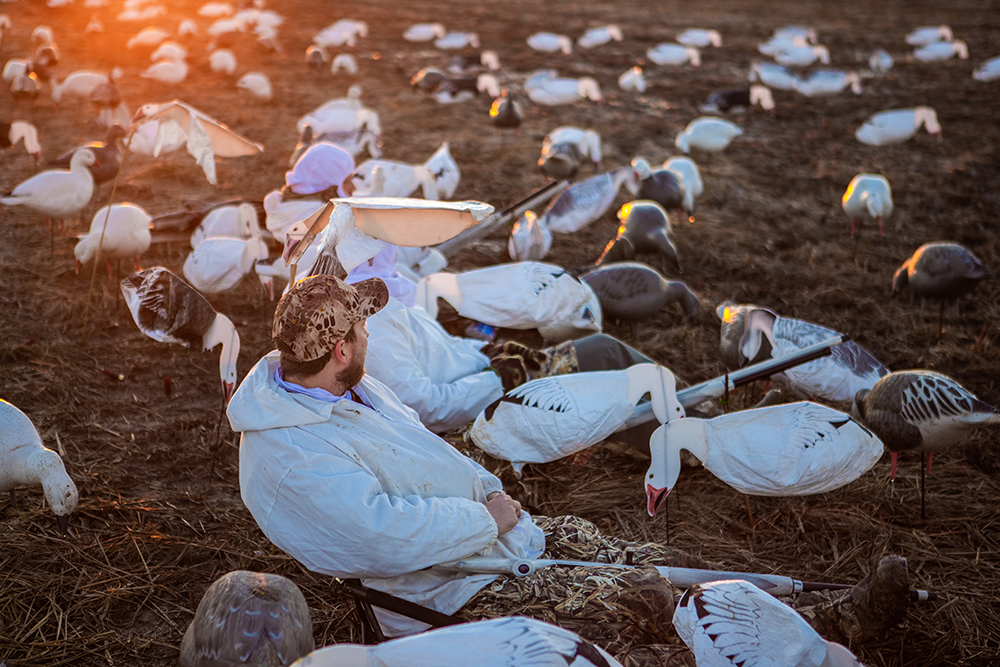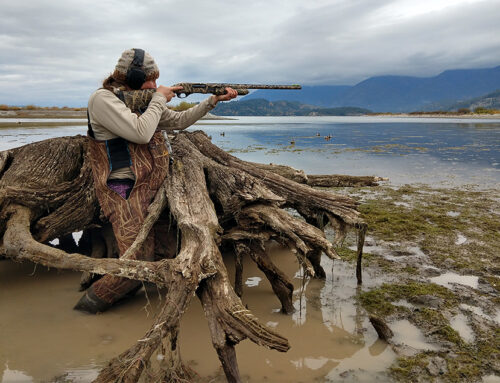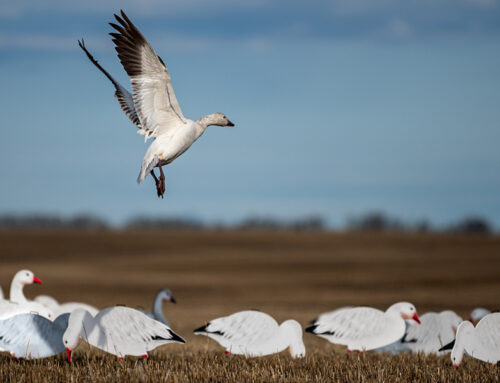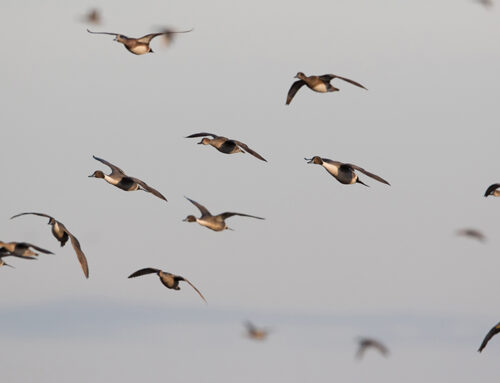Move the ‘X,’ Find Success
“Close enough” only works with horseshoes and … snow geese?

By Brad Fenson
A flock of 20 snow geese flew past the end of our field. One glance at the decoy spread generated excitement, and the birds, primarily juveniles, came with reckless abandon. Wings and bodies swayed back and forth through the air. The birds whiffled their wings to lose altitude as fast as possible. Looking for a place to land, the geese slowed and drifted over us at less than 20 yards. Shotguns roared, and white feathers drifted on the breeze.
Flocks colored the sky as far as we could see and lined up for a landing. Shotgun barrels got finger-burning hot, and we scrambled to find more shotshells. It was a great start to the hunt, and the onslaught of birds was like the geese had flipped a switch to declare dinner time.
The hunt had been planned for the evening, with a better wind and cloud cover forecast than the morning. Big snow shoots always work better when orchestrated under the best conditions though, morning or evening. An hour earlier, strings of snow geese winged past the field we were hunting without giving our decoys a look. The rest of the hunting crew started to worry loudly that the white geese would disappoint. It was early, and I knew the birds were bouncing between loafing and drinking water areas before dinner.
We could intercept them, but it would require moving the ‘X’—that sometimes seemingly mythical place where the birds want to be en masse. Here’s how you can apply the strategy this spring.
Read the Field
Edging the truck and decoy trailer into the wheat stubble field, we paused briefly to wet a finger and stick it out an open window. Old technology still works when reading environmental factors for a waterfowl hunt. The forecast and my finger told me that partly cloudy skies, a steady westerly breeze, and cooling temperatures made ideal conditions for an evening snow goose hunt.
The snow geese had bombarded the field the night before, and we were confident we would see birds return. The field was littered with tracks and white feathers, leaving little doubt that it was a preferred feeding area. Snow geese are always unpredictable compared to other fowl, which is part of the challenge that continually draws me back. There was a long, rolling hill through the middle of the field, divided by a long finger of mature aspen and willows. The birds were difficult to spot, down in a draw and against the trees. The waves of incoming birds were the only way to locate the feeding area.
In most cases, hunters look for the magical spot in the field where the birds want to land. The more exact your location, the better the odds of birds decoying in your face. In this case, a line of stubble that edged up to the trees was the obvious ‘X,’ but not a spot conducive to decoying birds. The west end of the field was also recently cultivated, forcing us to set up farther east, where the stubble was dense and provided good feed.

Mimic a Feed
Understanding how snow geese feed, interact, and target birds of a feather in the field is essential to setting decoys and blinds for success. They migrate, stage, and concentrate in huge flocks. Ducks and dark geese land downwind of their friends already in the field. However, with snow geese, following hundreds or thousands of your friends to the field in this manner would mean the groceries are always picked over.
Watching snow geese feed undisturbed in a field is like watching a game of leapfrog. The birds farthest downwind continually fly to the front of the flock at the farthest point upwind. Staying ahead of the flock means better feeding opportunities. The main flock on the ground either walks outward from the central landing area or leaps ahead of others on the ground. The pattern is easy to duplicate with decoys, with a large, dense group of birds upwind, and with lines of decoys stretching downwind.
We set the main body of decoys about 100 yards east of the cultivated cropland. That ensured plenty of landing room and prime feed for a larger flock of geese. We bunched a third of the decoys upwind and strung lines of decoys down the field for 300 yards. The strings of decoys act like a runway for incoming birds to follow and slowly descend in elevation. The strings of birds often cover an entire field or several hundred yards. The strategy also blocks birds from landing short and starting another feeding mob.
In some cases, groups of decoys are set 500 to 600 yards out to make it look like the area had been fed out and most birds had leapfrogged forward to the larger group. We used Alps Snow Goose Chairs with zero-gravity seats and dressed in white to become part of the decoy mob. It took 45 minutes to set up 800 Final Approach snow goose socks and silhouettes.
We had moved the ‘X’ about 300 yards and picked ideal conditions to draw the birds. From a snow goose perspective, there were no sidehills or slopes to maneuver, and the landing zone was flat ground with dense stubble. Incoming birds would follow the decoys to the mob and try to land ahead of it.
Some of this I learned while participating in outfitted hunts, which are great learning opportunities, not to mention they save you hours of scouting for your hunt. Paying attention to what the professionals do when setting up a shoot has taught my crew some valuable lessons, such as the paramount importance of deciphering a perfect landing zone under specific wind conditions to fit the blinds and decoys.
Birds want to land into the wind and on flat ground where the feed will be abundant. On one hunt, the outfitter drove circles in the field for 15 minutes before knowing the exact spot to set up. There were side hills to push birds off center, and finding a flat area for the landing zone proved to be worth the extra effort. The experience was a lesson in working with geography and other obstacles in the field to find the sweet spot.
Find the Hide

The sheer number of eyes in the sky on a decoy spread makes snow goose hunting challenging. Attention to detail is required to keep everything natural, with nothing that looks out of place or alarming to a wary goose. Successfully shooting snows out of A-frame blinds means blending into the natural cover along a creek, wetland, fence, or other feature with grass or shrub cover. In most cases, layout blinds or goose chairs are used to keep a low profile and blend into the environment. The layouts and chairs are excellent options where natural cover is not available and where you are decoying birds to an open field. Wearing white clothing helps hunters blend into the decoys and become part of the natural attraction to incoming birds.
Always look for natural concealment, though. A low spot in our field had lodged wheat, which is long stems that had been twisted in the wind or rain. They are natural-looking spots and prime feeding areas that birds target. The extra cover was ideal for hiding our chairs and taking advantage of a feature to disappear. A dip, ditch, standing or twisted grain, grass, or other feature to hide is worth using, even if you have to move the ‘X.’
An example occurred while spring snow goose hunting with Prairie Sky Outfitters in Saskatchewan. Over 20,000 snow geese were working a field. The volume of birds meant they hopscotched and pushed to the edges. We set up in the dark the following day, and with perfect wind, we stretched decoys across the field, over the fence, and into the adjacent field. The grassy fenceline was the perfect hide for our blinds, and the birds had no issue jumping the fence to follow the flock. We finished flocks with thousands of birds swirling around us in a deafening display of birds coming to a new ‘X.’
In this case, space to hide hunters and for incoming snows to land wasn’t an issue, but it can be. Snow geese are often spotted in prime feeding locations where it is easy to decide where and how to set up decoys and blinds. However, the birds often leapfrog into tight quarters where it would be impossible to set decoys and draw incoming flocks to shooters. So when considering a new ‘X,’ the equation must account for a prime feeding location—which can accommodate flocks of 100 geese or more—plus opportunities for hiding hunters. And there must be lots of room upwind, or the birds will drift to the sides and not line up on the hunters. The two-part equation will lead to more success.
Smaller Spring Spreads
Spring snow goose hunts can be different from autumn. Snow geese often target sheet water or shallow wetlands. The water is accessible for landing, and birds walk into dry areas of the field to feed. The transition areas between water and field are great places to hide hunters, with decoys spread through the water and upwind into the field. Spring conditions in an agricultural field look similar to the soggy tundra where snow geese nest. That’s when, after months of hunting pressure, smaller setups can be a steady draw for snows. A theory is that they are anxious to see their nesting grounds and steer away from the big groups where they have been shot at repeatedly.
The water and small groups of decoys can be deadly on adult geese that have seen lots of hunting pressure. Such sets can be highly effective when shooting traffic along a flight line of feeding birds. It creates an ‘X’ that the birds had not considered previously.

Juvie Donut
Juvenile snow geese are not as focused on prime feed as adult birds. The gray youngsters are more social and look for safety and companions on the ground. Where hunters hide in the decoy mob, create a “donut hole” in the decoys that is 20 yards wide and 25 yards from the blinds. Small groups of juvies, singles, and doubles will target the hole and land short of the mob. The donut hole will have birds at an ideal range for shooting, with feet down and wings backpedaling. The other advantage is to draw the birds’ attention and have them look at the ground before ever getting to blinds and hunters. The juvie donut can often save the day and allow hunters to have steady gunning at small groups that decoy exceptionally well.
Juvies are often the first birds to decoy into a spread, and geese landing in the hole provides confidence for larger flocks of birds coming in behind. Allowing some juvies to land can often finish flocks with hundreds of confident and excited birds.
‘X’ Factors
Snow geese are challenging to hunt, but that is part of the allure. The hunt should always be about the experience, the birds, and what can be learned in the field. One of the most rewarding aspects of snow goose hunting is developing a game plan with other hunters and watching it work. Moving the ‘X’ can be done with careful consideration and execution.
Brad Fenson is on the ‘X’—most of the time—in Androssan, Alberta.

A wedge of geese flies through a cloudy sky.







Leave A Comment